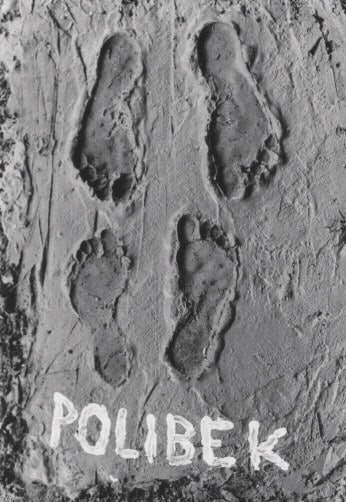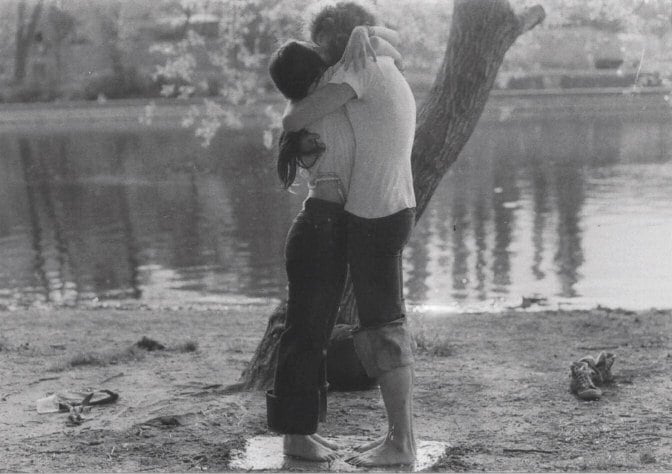Jiří Kovanda
Between two kisses
(11 May 1976, Prague, Strelecky ostrov – 10 March 2007, London, Tate Modern)
When the theoretician Pavlína Morganová from the Science Workshop of the Academy of the Arts in Prague was preparing her project to map out the Czech contemporary art scene, she had no idea what reaction it would have. She decided to contact a group of visual artists and ask them to name five colleagues without whom they couldn’t imagine the contemporary art activity. She then used the acquired information to send the same request to other five acteurs, working on the principle of multiplicity. Soon she gathered enough relevant information to have a rough idea about the Czech art scene and about the importance or substitutability of some of their representatives. The net started expanding and in the middle of it she found names, which personified the most important nodular points of the newest artistic activities. Next to Adriana Šimotová, the grand dame of Czech visual culture and the unique Milena Dopitová, it was Jiří Kovanda who was at the centre of his colleague’s interest.
Many insiders were delighted by the recognition of this modest and patient representative of the hard-to-overlook generation of action artists and performers of the last third of the 20th century (Petr Štembera, Jan Mlčoch, Karel Miler, Milan Knižák, Zorka Ságlová, Vladimír Havlík, Milan Kozelka and others. These artists bore witness to the absurdity of Husák’s regime and they were passing on a message that could be perceived as an attempt to arrest ‘normality’ in the world based on Kafkaesque principles. In the basements of universal interest or even in the depositories of Prague museums, just like in Kafka’s Castle, this circle of like-minded authors created, outside the official programme, outside opening hours and exhibition rooms of prestigious institutions, a micro-world full of non-aggressive conspiracies. This ongoing creative séance wasn’t trying to defy the system and definitely didn’t have the character of political resistance. It rather expressed the conviction of the involved artists that it is possible to dream, even in a geographical space surrounded by barbed wire and full of secret police agents.
This unofficial milieu was designated for the invited only – the trustworthy and those who were ‘in’ – the consumers of independent art. Their exterior activities which sometimes included the spontaneous reactions of the accidental public, contained strong moments of schizophrenic ambivalence. On the one hand they became the expression of the impossibility of dignified participation in any official art activity and at the same time they spotlighted the extent of their stoicism. The third criterion of authenticity of this activity epitomised the moral credit of artists not laden with the undignified partnership with the untrustworthy system and a personal satisfaction from the realisation of intelligent, comprehensive and interesting creative gesture.
The period of real socialism was playing up to this ambiguity. Every person had to judge what they could discuss in the privacy of their own home, what they could talk about with friends and with what topics or their interpretations they could mention in public. That explains why the most common reaction of passers-by the independent performances was a sad apathy and a serious lack of interest (On the Escalator, 3 September 1977). These aspects of social behaviour created a sharp antithesis to the communication models on which Kovanda’s actions were and are still based – eye contact, tactile contact and verbal contact. The artist was repeatedly trying to get a natural response from his public by using quixotic efforts, which were well lost in advance. At the same time, the absence of adequate response is no doubt a glib testimony to the mood of the time (Kontakt, 3 September 1977).
Kovanda’s early productions, dating back to the end of the 1970’s, is documented with original black and white pictures, in which the innermost make up of the main performer, basically an introvert, contrasts with his concerted effort to overcome his own social limits. With regards to the author’s institutional position at the time and his economic possibilities, the only real (and achievable) tool guaranteeing a partial immortality of his ephemeral art was a small size photograph. The photographs were often accompanied by pieces of office paper covered with descriptions written on a typewriter, which postulate the main motives and the method of realisation of the performance. The distance of thirty years since the realisation of these under-the-counter and yet fresh art works can intimate a degree of suggestive nostalgia to the contemporary audience, as happens in today’s era of developed information technologies with the black and white analogue process and with the phenomenon of the typewriter – the best friend of all intellectuals of the 20th century. The small format of the photograph in combination with typewritten messages organised into space-saving minimalist blocks, becomes Kovanda’s ‘trademark’. This strategy of expression was the basis for the accented conceptualism and minimalism, just as the simple limits of socialist production.
At the time of the heightened interest in Kovanda’s work, dating back to roughly the second half of the 1990’s, the question of the actual and accepted method of visual rewriting of his lost or damaged photographs was often mentioned. Curators, who show the work of this author in various exhibitions and in different contents, have argued whether his original negatives – transferred into binary data and enlarged with the help of the new technological possibilities to monumental proportions – are sufficiently authentic or whether their testimonial value could be too far from his original intentions. The few years, which passed since the first application of this formal shift, proved how farsighted this secondary creative gesture was. Realities of past times suddenly came alive in the changed social conditions through large format digital prints. By getting rid of the historical patina, Kovanda’s projects perhaps lost the sentiment generally hidden in every old documentary picture. (Kovanda’s original documentary images naturally had the documentary dimension). On the other hand, by being updated, they images become a contemporary and understandable phenomena for the new generation. The element of timeless, for which the original concept was intended, the notion of light touch, non-verbal communication or perhaps misunderstanding, remained unaffected by these technological changes.
After the phenomenal success, which the author enjoyed in the previous decade as a result of the presentation of his projects from the 1970’s at international festivals of modern art, he decided on another, quite a radical step. At the prestigious space of the Tate Modern in London he presented his new show (Kissing through the Glass, 10 March 2007), the remake of his key performance (On the Escalator, 3 September 1977–10 March 2007), and he documented all on video. Beside his digital video recordings of performances, Kovanda works with new minimal situations or installations. They follow on his previous work from the 1980’s (Salty Corner, Sweet Arch, winter 1981; Tower Made of Sugar, Spring 1981, Pile of Needles and Nails, Spring 1981). He documents his installations digitally and it reveals some incredible cooccurrences to the viewer, which are always there but usually go unnoticed. We can also include the programmed expansion of a tiny pea into this group of visual micro-stories, which for the artist becomes a symbol of the function of an atomised unit (man and gestures, relationships, little moments) or it becomes a juxtaposition to the overall context of its existence (Necklace, 11 September 2007; without title – Resistance, 30 October 2007).
The documentary exclusivity of Kovanda’s performances or his sitespecific installations has been proved by the gradual change of the character of the context (of the accidental actors or the specific environment) in which they were created and which is visualised within their framework. In the 1980s, the artist introduces an inner manner of experiencing, represented by the form of personification of individual objects, while in the 1970s it was more about small groups of people. In his new work, Kovanda also moves along the border between action and installation, The significant moment, which confirms the presence of the secondary reflection of the time, is the undisputed reality that while the accidental walkers in the half-empty streets of the communist era try to blend with the crowd as much as they can, the people captured on pictures in Tate Modern express their individuality and smile. With his urgent and yet compelling and humble, but at the same time selfconfident creative gesture, Jiří Kovanda placed himself among the legends of contemporary Middle European visual culture while he preserved his unique ability to comment on our social and emotional cognizance (or the lack of it).
#11 Performance
Archive
- #45 hypertension
- #44 empathy
- #43 collecting
- #42 food
- #41 postdigital photography
- #40 earthlings
- #39 delight, pain
- #38 death, when you think about it
- #37 uneven ground
- #36 new utopias
- #35 living with humans
- #34 archaeology of euphoria
- #33 investigation
- #32 Non-work
- #31 Body
- #30 Eye In The Sky
- #29 Contemplation
- #28 Cultura / Natura
- #27 Cars
- #26 Documentary Strategies
- #25 Popular Music
- #24 Seeing Is Believing
- #23 Artificial Worlds
- #22 Image and Text
- #21 On Photography
- #20 Public Art
- #19 Film
- #18 80'
- #17 Amateur Photography
- #16 Photography and Painting
- #15 Prague
- #14 Commerce
- #13 Family
- #12 Reconstruction
- #11 Performance
- #10 Eroticon
- #9 Architecture
- #8 Landscape
- #7 New Staged Photography
- #6 The Recycle Image
- #5 Borders Of Documentary
- #4 Intimacy
- #3 Transforming Of Symbol
- #2 Collective Authorship
- #1 Face











